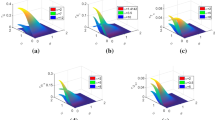Abstract
Maximally quantum entanglement is vital for the application of quantum communications and quantum information, and plays a fundamental role in quantum information. In this paper, we present a new approach, via reduced density matrices, to search the maximally seven-qubit pure states. Through the numerical calculations and analysis, we construct a simple form of maximally seven-qubit pure states. Further, we find maximally entangled seven-qubit states whose marginal density matrices for subsystems of 1, 2 are completely mixed. Moreover, We show that average bipartite entanglement of maximally seven-qubit pure states is also \(\frac{19}{140}\). Our result provides the research foundation for the development of quantum communication and quantum information.
Similar content being viewed by others
References
Facchi, P., Florio, G., Parisi, G., Pascazio, S.: Maximally multipartite entangled states. Phys. Rev. A. 77, 060304(R) (2008)
Brown, I.D.K., Stepney, S., Sudbery, A., Braunstein, S.L.: Searching for highly entangled multi-qubit states. J. Phys. A Math. Gen. 38, 1119–1131 (2005)
Borras, A., Plastino, A.R., Zander, C., Casas, M., Plastino, A.: Multi-qubit systems: highly entangled states and entanglement distribution. J. Phys. A Math. Gen. 40, 13407 (2007)
Zha, X.W., Yuan, C.Z., Zhang, Y.P.: Generalized criterion for a maximally multi-qubit entangled state. Laser Phys. Lett. 10, 045201 (2013)
Che, J.L., Wu, H.: Construct Multipartite Maximally Entangled State via Recurrence Relation. Int. J. Theor. Phys. 58, 584–590 (2019)
Zhao, C., Yang, G., Li, X.: Separability criterion for arbitrary multipartite pure state based on the rank of reduced density matrix. Int. J. Theor. Phys. 55(9), 3816–3826 (2016)
Purwanto, A., Sukamto, H., Yuwana, L.: Quantum Entanglement and Reduced Density Matrices. Int. J. Theor. Phys. 57, 2426–2436 (2018)
Choong, P.S., Zainuddin, H., Chan, K.T., Husain, S.K.S.: Higher order singular value decomposition and the reduced density matrices of three qubits. Quantum Inf. Process. 19, 338 (2020)
Author information
Authors and Affiliations
Corresponding author
Additional information
Publisher’s Note
Springer Nature remains neutral with regard to jurisdictional claims in published maps and institutional affiliations.
Rights and permissions
Springer Nature or its licensor holds exclusive rights to this article under a publishing agreement with the author(s) or other rightsholder(s); author self-archiving of the accepted manuscript version of this article is solely governed by the terms of such publishing agreement and applicable law.
About this article
Cite this article
Huo, G., Huang, H. & Zha, X. Searching for Maximally Entangled Seven-Qubit State via Reduced Density Matrices. Int J Theor Phys 61, 253 (2022). https://doi.org/10.1007/s10773-022-05223-6
Received:
Accepted:
Published:
DOI: https://doi.org/10.1007/s10773-022-05223-6



